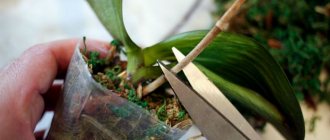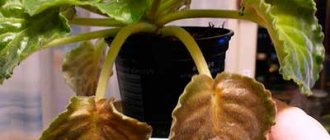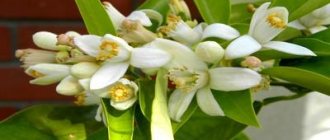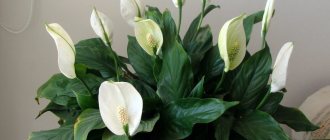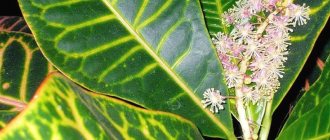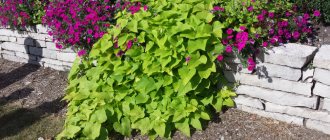What is the difference from other types?
The main difference between the plant and other varieties of spathiphyllum is its decorative form . During the flowering period, a long peduncle is located above the bush, at the tip of which a wide white blanket blooms (you can read about other varieties with white flowers here). The size of the flower is not inferior to the size of the leaves.
Spathiphyllum: about the plant
The genus Spathiphyllum belongs to the Araceae family. Presumably, it includes 45 species. The main range includes the tropical forests of Central and South America. Also, some varieties are found in Southeast Asia. The plant loves a humid environment, so in nature it grows on the banks of reservoirs.
The name "spathiphyllum" comes from the Greek language. Its first part, “spate”, translated into Russian means “bedspread”. The second part of the word, “phyllum,” translates as “leaf.” Among the Indian tribes living in South America, the plant was considered sacred. During its flowering period, marriages took place. The Indians believed in the ability of spathiphyllum to bring family happiness to girls.
Subvarieties and their photos
Silvio
The variety is characterized by graceful inflorescences and a lush bush. The flower size is 75 cm.
Silvio is growing fast. The surface of the leaf plate is smooth, length 30 cm, edges wavy.
Lauretta
The variety was obtained in 2001. The height of the bush is 80 cm, and the width is 85 cm. The leaves are elongated and oval in shape, have light veins, and the inflorescences are directed upward on a high petiole.
Spathiphyllum Benito
The peculiarity of an adult plant is its ability to produce up to 15 inflorescences during the flowering period. The plant is also resistant to external factors: light and excessive watering.
The size of the bush is compact, the leaves are narrow, and their length is 35 cm. Their surface is glossy and smooth.
Spathiphyllum Chico
This variety grows to large and voluminous bushes. Its height is 70-75 cm. The flowers are large, snow-white, and have the shape of a cone. The variety is easy to care for.
If you are interested in this unusual and beautiful flower, then we suggest that you familiarize yourself with other types of spathiphyllum. We will tell you in detail about growing and caring for varieties such as Strauss, Cupido, Wallis, Picasso, Alana, Domino, Sensation, Chopin, as well as varieties with red and white flowers.
The history of the origin of giant varieties with large leaves
Large spathiphyllums were developed about 50 years ago for landscaping shaded buildings. They reach a length of more than 1.5 m and tolerate partial shade perfectly. The plants lack a stem. Huge leaves occupy 90 cm of the entire height of spathiphyllums. They reach a width of 40 cm. A spectacular white flower 30-35 cm long is located in the center of the plant.
The first flower was found and described in detail by the German biologist Gustav Wallis in the 19th century. Then the plant became popular in European countries and Colombia. The flower immediately fell in love with many breeders, who subsequently developed the Alan variety.
READ MORE: Roof of a house 80 photos of the main types of shapes and coatings Features of various structures and their application
Bloom
When and how?
Flowering of spathiphyllum sweets begins at 6-7 months. The inflorescences last a long time - more than a month. Thanks to this quality, spathiphyllum flowers are perfect for cutting.
Care before and after flowering
Before flowering, the plant needs good lighting and fertilizing. You need to add compounds containing phosphorus and potassium, but reduce nitrogen-containing preparations.
Attention: water moderately as the soil dries, but not allowing it to dry out completely.
After flowering, remove the dried bud, stop adding nutrients, and water by spraying. Without this, the leaves will lose their elasticity and droop.
What to do if a flower does not produce buds?
If spathiphyllum sweet has stopped blooming, then the reasons may be as follows:
- Insufficient lighting. It is best to place the flower on the east side.
- Lack of timely watering. If the layer of soil begins to dry out, the plant will drop its buds and not bloom. It is important to control watering and use soft, settled water.
- Incorrectly selected pot. You should not use containers that are too large, since flowering is only possible if the roots occupy the entire space of the pot.
Landing
It is recommended to plant this plant in spring. Although for representatives of the tropics, this is not important. The main requirement is that the air temperature be at least 18 degrees.
To plant Spathiphyllum seeds, you need a small container, which must first be prepared by dousing it with hot water.
The soil should be light and loose. You can use a specialized mixture for aroid or tropical plants, mixing it with a small amount of sand.
You can add some charcoal and finely crushed bricks, coarsely ground tree bark, and coconut fiber. The total volume of additives should not exceed 5% of the total mass of the prepared soil. This allows the resulting substrate to be more breathable and moist.
How to plant?
Growing spathiphyllum from seeds is a very long process. In this case, the plant will bloom only in the third year after planting. But the advantage of such a plant will be its undemandingness to humidity, and the flower itself will be strong and adapted to environmental conditions.
Spathiphyllum should be planted in spring.
- The seeds are placed in moist, loosened soil by simple pressing.
- Containers with future seedlings are placed in a small greenhouse, which is regularly ventilated.
- To germinate seeds, a temperature of 20-25 degrees and high humidity is required.
- When the crops grow by 3 cm, they should be planted in separate pots.
- Three months after the plants have been planted, they can be fed.
Although the plant is not considered too demanding, certain care rules must be followed. It is important for the owner of a flower to know not only the secrets of planting, but also the general principles of maintenance.
The plant requires the use of nutritious soil. To grow an indoor flower, it is recommended to use 2 parts of peat and humus, add 1 part of leaf soil and river sand. Mix everything thoroughly and fill the planting containers.
Selecting soil for planting
Important! As the bush matures, it is necessary to regularly add the nutrient mixture. And once every three years you need to replant it into a new container using fresh soil.
For active growth, spathiphyllum requires moderate watering. It is necessary to moisten the soil only after drying.
Excessive watering can lead to root rot.
Feeding
One of the conditions for growth is the timely use of fertilizers. In winter, it is necessary to fertilize the crop once a month. In summer, feeding is carried out once every two weeks.
Complex preparations must be used as fertilizers. Before the formation of buds begins, it is recommended to use potassium and phosphorus fertilizers.
Important! Thoughtless use of nitrogen fertilizers can lead to a lack of buds.
Trimming
One of the rules for care is timely pruning. During the growth of the bush, it is necessary to carefully monitor the plant and remove all damaged leaves.
It is also important to remove flower stalks after flowering. Such actions will stimulate the appearance of new buds.
Home care
Selecting a location
It is advisable to grow the plant on windows facing north, east or west. Spathiphyllum Sweet needs good lighting, but not in direct sunlight.
What should the soil be like?
The flower prefers loose, nutritious soil with a neutral pH level. To prepare the soil, mix the following components in equal proportions:
- peat;
- humus;
- river sand;
- leaf and turf soil.
Landing
Planting activities are carried out in late February - early March.
Procedure:
- Place drainage at the bottom of the container and fill it with nutrient soil.
- Scatter planting material in the form of seeds over the surface of the ground, slightly deepening it.
- Spray the soil with water from a spray bottle and cover the plantings with polyethylene.
- Remove the cover every day for ventilation.
- The first shoots appear after 10 days, then remove the film and move the container to a lighted place.
- As soon as 2-3 leaves are formed, pick.
Temperature
In summer, during the flowering of spathiphyllum retinue, temperature indicators should be 22-24 degrees Celsius, and in winter – 16-17 degrees.
If the temperature drops to 13 degrees, the flower will slow down.
Watering
For moistening, use only settled water. The flower prefers abundant watering , which should be done 2-3 times a week. Pour water carefully so that it only hits the soil.
It is also important to spray, otherwise the leaves will begin to dry out. This needs to be done 2 times a day. In winter, moisten the soil once a week.
Top dressing
Apply nutritional compositions from March to September. Use mineral complex preparations. The solution should be slightly concentrated - 1 g per 1 liter of water. Before and after this procedure, water the flower thoroughly.
Apply fertilizing once every 2 weeks. For good and long flowering, use fertilizers with a predominance of potassium and phosphorus.
Trimming
After flowering, be sure to cut off the peduncle , otherwise it will absorb nutrients. Carry out pruning as close to the rhizome as possible. Dry and diseased leaves of the crop must also be removed. Treat all cut areas with crushed coal.
Transfer
Similar events are carried out in the spring, when the rhizome has grown to cover the entire pot. Since the roots are fragile, use the transshipment method, removing only a small part of the soil from the root system. If the rhizome begins to rot, then clean it up.
Take a pot a little larger than the previous one, be sure to take care of drainage. During the rooting period, reduce watering, and also cover the flower with polyethylene and ventilate 2 times a day.
Video
Name: Spathiphyllum Sweet Chico
Homeland: South America, Malaysia
The genus Spathiphyllum unites more than 30 tropical plant species originating from South America and Malaysia.
All hybrids grown as houseplants are derived from Spathiphyllum wallisii, native to Colombia. This is a low plant with paddle-shaped glossy bright green leaves about 30 cm long, with wavy edges and pronounced veins. Small and round true flowers of creamy white color are collected in an inflorescence (small spadix) wrapped in a white bract (spread). As they ripen, both the cob and the spathe acquire a green color. Spathiphyllum flowers are very stable and bloom for a long time. Many decorative varieties and varieties have been developed, both small ones, for example “Small”, which is widely used in compositions, and very large ones, for example “Mauna Loa” and “Giant”. Other popular varieties include Bold, Feeling, Adagio, Prelude and Palace.
GROWING
Spathiphyllum Wallis is cultivated only as a houseplant. When growing, mineral fertilizers must be used. In spring and summer from the end of March to the end of September, once every 10 days, when watering highly developed specimens, diluted liquid fertilizer is added to the water (to feed weak plants, fertilizer is taken in a lower concentration). During the rest of the year, regardless of size, plants are fed once a month. Spathiphyllum is ideal for hydroponics.
LIGHTING AND SITE SELECTION
Spathiphyllum prefers a well-lit place, especially in winter. In summer, you need to make sure that direct sunlight does not fall on them, which causes burns to the leaves. Partial shade is best for them.
TEMPERATURE
Winter temperatures should not be high: optimally - about 16 ° C - then a dormant period begins, which promotes flowering in summer. The plant can tolerate temperatures not lower than 12-13 ° C. In the summer months, spathiphyllum feels comfortable at a temperature of 25-27 °C. Does not like sudden temperature changes and drafts.
WATERING AND FERTILIZER
It is necessary to constantly maintain moderate, or possibly high, humidity. This requires abundant watering (there must be good drainage) and frequent spraying of the above-ground parts with water. To establish the optimal humidity level, you can also place the pot in a tray with expanded clay. In winter, water less often.
APPEARANCE CARE
The leaves are cleaned with a damp cloth (the use of lustrating solutions is not recommended). Withered leaves and inflorescences (the spadix enclosed in a spathe) should be removed by cutting them off at the junction with the stem.
TRANSFER
If it is clear that the roots of the plant have filled the entire volume of the pot, then begin replanting. This operation is carried out in the spring, or even annually, using ordinary universal humus, which is used to fill a pot 1-2 sizes larger than the previous one.
REPRODUCTION
The easiest way to propagate spathiphyllum is by dividing the bush in the spring. The roots are also carefully separated. Plants obtained as a result of division should be planted in pots or cups filled with loose peat soil with a pH of 5.5-6, with a good drainage layer on the bottom; the temperature is maintained at about 20 °C.
DISEASES AND PESTS
Spathiphyllums are usually quite resilient plants. When attacked by mites, small yellowish specks appear on the leaves; get rid of them by treating them with acaricides, and also by maintaining high humidity. Scale insects hiding in the most sheltered places provoke gradual withering and death of the plant. This pest is eliminated by treating with a cotton swab dipped in alcohol, after which the plant is sprayed with an anticoccidal drug. If aphids appear on young shoots, this leads to deformation and curling of the leaves into tubes. Appropriate processing required.
How to propagate?
Cuttings
It should be carried out in spring or summer. Procedure:
- Cut off the leaf rosette and place in water. You can use raw sand. Wait until roots form.
- If they are already formed, then direct planting into the ground can be carried out.
Dividing the bush
It is better to divide the spathiphyllum bush in the spring. The separated part of the plant should have 3 strong leaf rosettes and part of a healthy rhizome.
Deepen the cuttings to the same depth as in the previous pot. Before dividing, soak the roots with water, wash them and untangle them. Then clean and powder the sections with crushed charcoal.
Seeds
Procedure:
- Plant the planting material in a container with moist soil, which consists of sand and peat. Cover the seedlings with polyethylene.
- Maintain soil moisture by spraying.
- Open the film every day until seedlings form.
- Plant them in separate containers when 2-3 leaves are formed.
Reproduction
The easiest way to propagate a perennial is to divide the bush during annual replanting. To do this, remove the plant from the old container and clean the roots from the soil. Then cut off all the darkened and rotting roots. Using a sharp, disinfected knife, cut the bush into several parts, leaving several leaves and a branched root system on each. The sections are powdered with cinnamon or activated carbon.
For planting cuttings, soil is prepared from the following components:
- 2 parts wood soil;
- 2 parts humus;
- 1 part sand;
- 2 parts peat.
Small pots are filled with this soil mixture. Expanded clay drainage is first laid in each. The divisions are placed in the center and the voids are filled with fresh soil. After planting, the plants are watered.
Diseases and pests
Most often, diseases affect the leaf blade, resulting in the following problems:
- Yellowness of leaves. It occurs when watering is infrequent and the humidity in the room is too low.
- Drying and curling of leaf tips. This problem occurs when there is insufficient humidity and cold air.
- Pale leaves. The reason is that the lighting is too bright.
- Leaves may turn black if the root system is diseased. And this happens as a result of excess moisture. Also, blackness on the leaf plate is the result of unbalanced fertilizing.
Dangerous pests include:
Spider mite. It is located on the inside of the leaves, enveloping it in a cobweb. After a while, the leaf plate dries out. To combat, use a soap solution, only first clean the leaves from cobwebs. Onion solution (100 g of peel and 5 liters of water) is also effective.- Aphid. It settles at the bottom of the leaf blade. This insect is characterized by rapid reproduction. It feeds on the sap of the plant, causing the leaves to curl. To combat, use a solution of nicotine sulfate (1 g per 1 liter of water).
- Shield. It covers the leaf blade with dark spots. For processing, a soap solution with the addition of kerosene and tobacco is used.
Prevention of various problems
The following recommendations will help prevent the development of problems when growing spathiphyllum:
- The flower responds positively to moisture, so water it abundantly. But it is important not to overdo it, as excessive watering will cause the leaves to turn black and yellow.
- The plant does not like direct sunlight, but it cannot live without sunlight. So it is important to find a place with diffused light.
- Spathiphyllum suite does not like drafts and sudden changes in temperature. In summer the temperature should be 18 degrees, and in winter 16 degrees and not lower.
Spathiphyllum Sweet is a plant that is chosen for home cultivation. Its peculiarity is its long and beautiful flowering. But this can only be achieved with careful care. In addition to stimulating flowering, this will prevent the development of diseases.
Description
Spathiphyllum Sweet Chico is an indoor shrub plant that belongs to the hybrid type. Its characteristic feature is the absence of a stem. The plant can reach a height of 70-80 cm. The leaves have a rich green tint. They are on long petioles and have an oval shape. Spathiphyllum foliage has a smooth coating with straight veins.
During flowering, the plant appears a large number of arrows growing from the soil. Because of them, spathiphyllum looks like a fan.
The inflorescence is usually white or white-green. It is surrounded by an outer petal, which is also called the veil. When the plant fades, the outer petal takes on a greenish tone.

